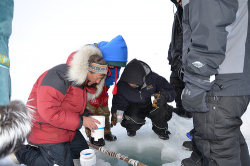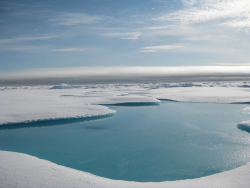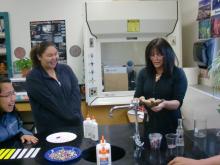What Are They Doing?

Research sites ranged from lagoons to open coastal systems and each site was used to examine linkages between biological communities and organic matter inputs from land. Measurements of water and sediment chemistry, and benthic and water column community characteristics were used to evaluate the importance of terrestrial inputs under different hydrologic/hydrographic conditions.
Understanding the fate of terrestrial carbon in arctic coastal waters is especially important now as the arctic system enters a period of rapid climatic change. Changes in terrestrial organic matter export could influence the productivity and roles of organisms in arctic coastal waters. Such shifts have consequences for local human populations that fish and hunt for subsistence and for the broad scientific community interested in land-sea coupling.
In addition to their research, the team continued their successful K-12 outreach program entitled "Climate Change in the Arctic: An Interactive Program Linking Scientists with K-12 Students". This included the continuation of a summer field science program for native Kaktovik K-12 students. The Village Council has continued to express keen enthusiasm to involve school children in hands-on science activities that support learning of key science concepts.
In addition, PolarTREC teacher Jill Smith learned about the cultural importance of the annual bowhead whale hunt that began while she was in residence at Kaktovik. She had the opportunity to share this information through real-time video connections with her students in her home classrooms in Texas, enabling students from Texas to have direct dialogues with students in rural Alaska.
Where Are They?

Latest Journals

Dr. Kenneth Dunton is a biological oceanographer whose research is focused on estuarine, coastal, and shelf processes. Although his work spans from the Arctic to the Antarctic, his continuous studies of the arctic coastal ecosystem have spanned three decades. Dr. Dunton became involved with arctic studies involving kelp beds in 1977. His research also includes examining the distribution and biomass of benthic biota and the application of stable isotopic signatures to assess changes in trophic structure. Such measurements can help identify processes that are sentinel indicators of global change.
He has continued this work in the Chukchi Sea under funding from the Bureau of Ocean Energy Management (BOEM) and under a grant from the NSF to examine the linkages between watersheds and the nearshore lagoons of the eastern Alaskan Beaufort Sea. Dr. Dunton has published more than 80 peer-reviewed papers and has supervised over 20 graduate students and 11 post-doctoral fellows. He is active in K-12 outreach, obtaining two NSF grants that partner teachers and graduate students in K-12 classrooms. He implemented the annual summer science field program for kids in 2008 in partnership with the City of Port Aransas and the Port Aransas school district. He also implemented a summer science program for the native school children of Kaktovik, Alaska, on the Beaufort Sea coast in conjunction with the Arctic Refuge (USF&WS) that started in 2007. He obtained his BSc in biology from the University of Maine in 1975, his MS from Western Washington in 1977, and his PhD in oceanography from the University of Alaska-Fairbanks in 1986.
Dr. Dunton is currently a professor in marine science at the University of Texas at Austin. He has lived in Port Aransas since he and his wife Susan arrived from Fairbanks in 1986. They have three grown children, two of whom graduated from TAMU College Station and one from UT-Austin. He routinely cycles, surfs and swims. Learn more about Dr. Dunton here and here.

Dr. James McClelland studies nutrient dynamics in the environment, with a strong emphasis on understanding the role of land-derived carbon and nitrogen in coastal ecosystems. Environmental changes as a consequence of human activity, including changes in land use, land cover, and global warming, provide the context for much of his work. These changes are having a profound influence on transport of water and water-borne material from rivers to estuaries. In turn, changes in river inputs to estuaries are altering fundamental ecosystem properties such as primary production and food web structure. Much of Dr. McClelland's work has focused on the Arctic over the past decade. He co-founded the Arctic Great Rivers Observatory (www.arcticgreatrivers.org), a pan-arctic effort that has greatly improved estimates of river inputs to the Arctic Ocean and established a solid baseline for tracking future changes. His work in the Arctic has also included more focused studies on the North Slope of Alaska, examining nutrient transport and processing at a variety of scales. Dr. McClelland earned a B.S. in zoology from the University of Washington in 1991 and a Ph.D. in biology from Boston University in 1998. He became a faculty member at the University of Texas Marine Science Institute in 2006, where he is currently an Associate Professor.





